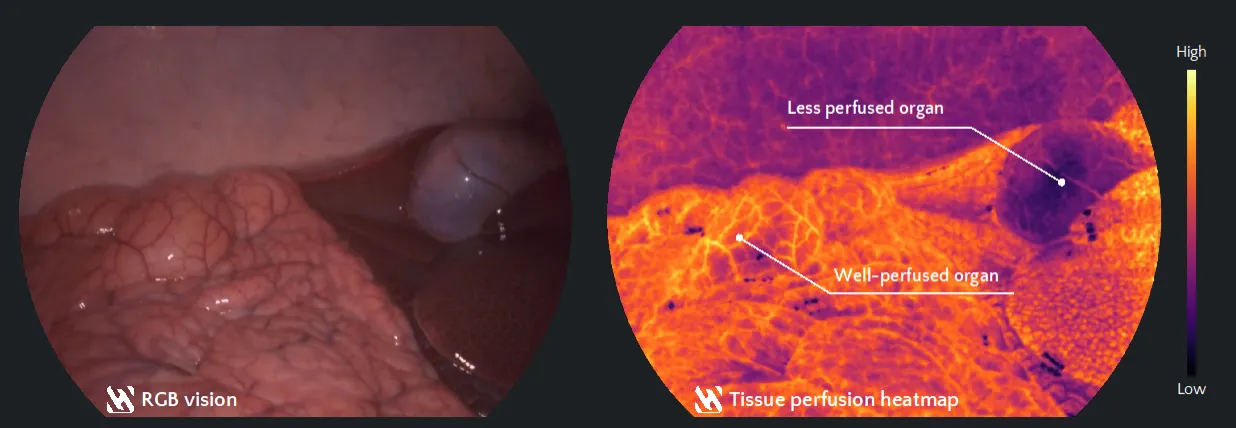Our machine vision technology leverages hyperspectral information far beyond the conventional red, green and blue colours that the human eye can see. By deploying real-time AI, we have developed a Hyperspectral Intelligence platform to extract tissue analytics information for surgeons to make potentially life-changing decisions for patients with high confidence.
Dr Michael Ebner, CEO and co-founder of Hypervision Surgical
11 October 2022
King's College London spin-out Hypervision Surgical Computer Vision Technology features NVIDIA technology to augment surgery study
In a first-time collaboration between NVIDIA and spinout company from the School of Biomedical Engineering & Imaging Sciences, pioneering computer vision technology has been used in an-vivo surgery study at IHU Strasbourg, France, to provide tissue-analytics information previously invisible to the human eye. It is the first time NVIDIA technology has been used in surgery.

In a first-time collaboration between NVIDIA and spinout company Hypervision Surgical Ltd from the School of Biomedical Engineering & Imaging Sciences, pioneering computer vision technology has been used in an-vivo surgery study at IHU Strasbourg, France, to provide tissue-analytics information previously invisible to the human eye. It is the first time NVIDIA technology has been used in surgery.
Hypervision Surgical uses Artificial Intelligence (AI) computing and GPU-accelerated high-performance computing to extract real-time tissue analytics from complex hyperspectral imaging data to assist surgical decision-making.
The NVIDIA Clara Holoscan software development kit, combined with the NVIDIA Clara AGX developer kit, provides the Hypervision team with edge computing resources and an AI-driven software development framework for building their technology platform.
The first example of Hypervision Surgical's Hyperspectral Intelligence augmenting the doctor's vision is a quantitative tissue perfusion “heatmap” that can be provided alongside conventional red/green/blue colour information, allowing for an intuitive display of tissue-analytics information for surgical decision-making.
For instance, perfusion information of bowel anatomy can help surgeons understand optimal resection margins during colorectal (colon/rectum) surgery thus having the potential to prevent serious complications for patients.
As part of the in-vivo study, Hypervision Surgical’s technology was used to guide a “keyhole” surgical procedure and provide real-time conventional colour imaging and tissue perfusion heatmaps side by side for visible anatomies.
The most common deployment approach to AI for surgical vision tasks currently relies on cameras such as those found in endoscopes live streaming their video data to a distinct compute infrastructure equipped with a frame grabber. In contrast, at Hypervision Surgical, we are designing a fully integrated imaging system where the compute capability is truly at the core. Low-latency, high-performance GPU operations are critical, from raw data capture to hyperspectral video reconstruction, data compression, and augmented visualisation. Working closely with NVIDIA products and experts allows us to take full advantage of cutting-edge hardware and define the boundary of real-time Hyperspectral Intelligence.
Professor Tom Vercauteren, CSO and co-founder of Hypervision Surgical
Real-time, high-resolution hyperspectral imaging requires processing live data streams.
Sampling tens of spectral bands across the visible spectrum, rather than the conventional three red/green/blue channels, results in a much more detailed view of the tissue’s spectral response.
However, this rich data stream needs to be processed quickly to avoid any delay in delivering and displaying information during the critical surgeries.
Hyperspectral Intelligence is ideally configured for taking advantage of GPU parallelism which leverages dedicated hardware engines for recording and playback of data streams without impacting the performance of the real-time live view for surgery.
To accelerate the commercial deployment of its solutions, Hypervision Surgical recently joined NVIDIA Inception, a free program that nurtures cutting-edge startups, which gives it prioritised access to computing technology and technical training.
As a spin-out from King’s College London, Hypervision Surgical’s collaboration with NVIDIA also bolsters the work between King’s College London and NVIDIA to build the gold standard for AI infrastructure in the clinic.

I am delighted and proud to see our King’s College London spin-out being able to leverage the unique collaboration we have nurtured with NVIDIA over the years. This is another brilliant example of the immense added value such public-private collaboration can deliver to bolster innovation in the healthcare sector. Hypervision Surgical is on a stronger and faster trajectory thanks to this collaboration.
Professor Sebastien Ourselin, co-founder and Head of School of Biomedical Engineering & Imaging Sciences, King’s College London
Hypervision’s work developing key clinical tools on the NVIDIA platform is a great example of how our relationship with King’s College London, whether with the AI centre or its spinouts, brings huge value to healthcare. NVIDIA Inception continues to provide critical support for start-ups, offering the latest hardware and software technology to accelerate their workloads and realise their value much faster.
Craig Rhodes, EMEA Industry Business Lead for Healthcare and Life Sciences at NVIDIA



